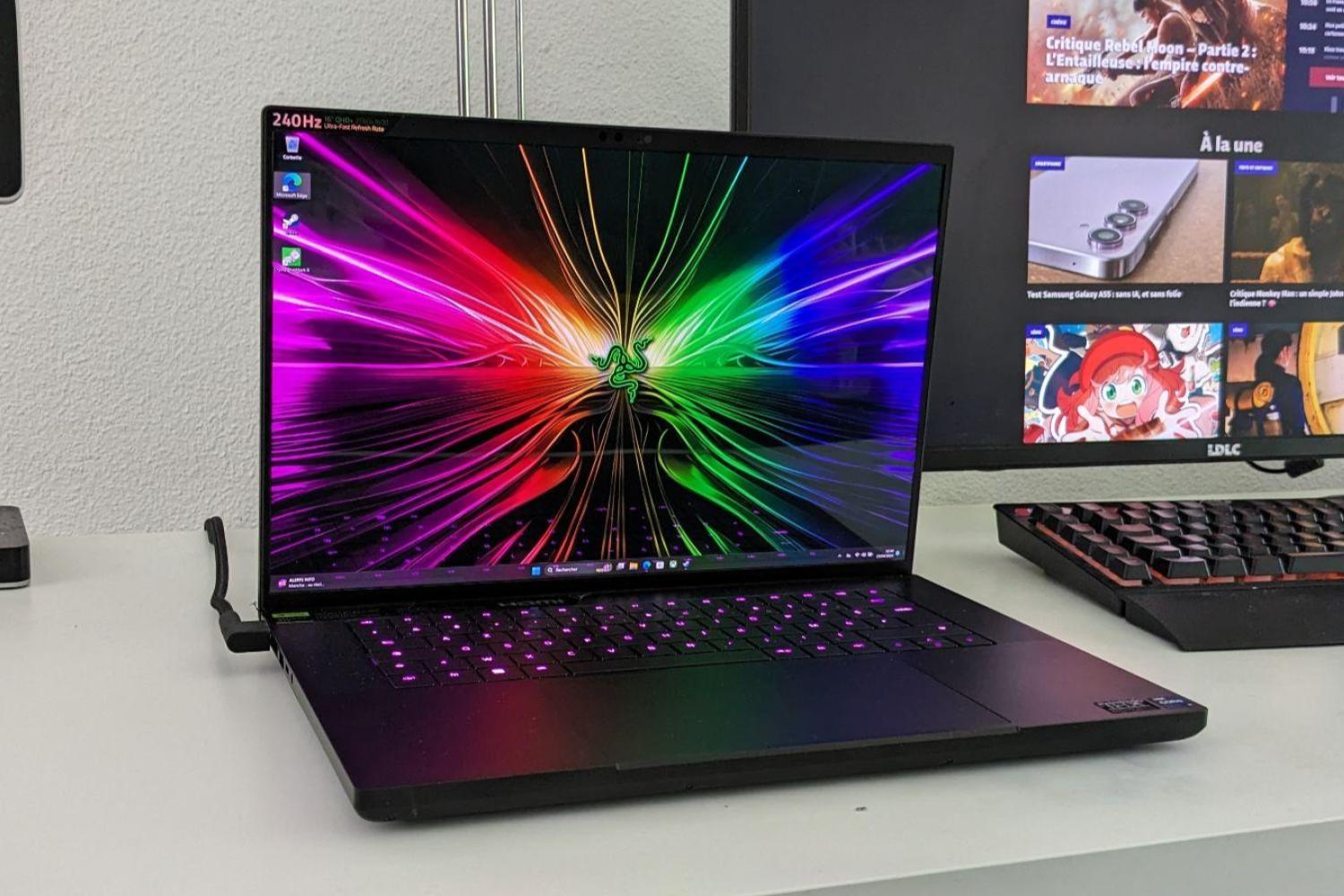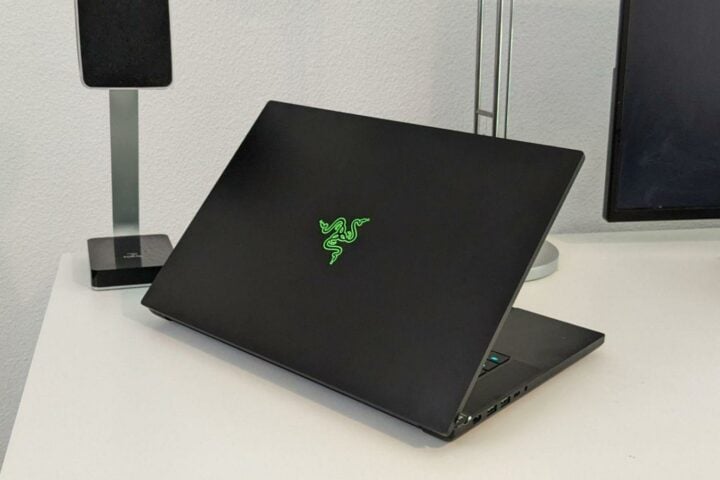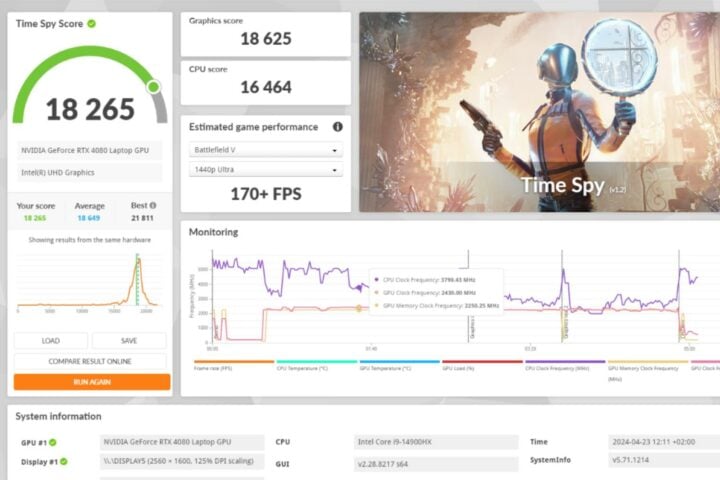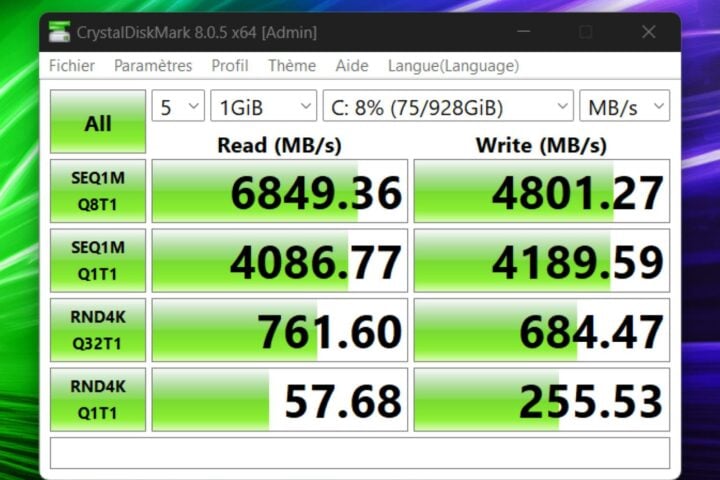We had the opportunity to test the new version of the Razer Blade 16, the older brother of the Blade 15 which passed through our hands last year — a good opportunity to compare the two machines. Will this model live up to the range’s reputation? Here is our opinion.
Upon opening the packaging, we find a machine with a design that is as simple and elegant as ever, with an absolutely flawless finish on all levels. This Blade 16 has one of the stiffest and most comfortable chassis on the market, with a very solid hinge and a surface that is very pleasant to the touch. No real surprise at this level.
On the other hand, those used to models like the Blade 14 may be a little surprised by its measurements. Blades have earned a reputation for being ultra-thin and light laptops, but this model is significantly heavier and thicker than its little brother, with slightly more 2 cm on the hinge, 2.2 kg on the scale et 0.8 kg for the charger.
A clear break with tradition, which isn’t necessarily good news in terms of pure portability. But in practice, this bias does not turn out to be particularly disturbing… and even quite relevantknowing that there is large cooling equipment under the hood (see below).
screen
The Blade 15 screen we tested last year set the bar very high. So we’ve been waiting for this model around the corner because we have to admit that the spec sheet is mouth-watering. Judge for yourself: this is a record OLED 16 inches QHD+ (2560 x 1600 in 16:10 format) clocked 240 Hz with a response time of 0.2 s. We are also entitled to a 100% DCI-P3 gamut coverage1:1000000 contrast ratio, plus perfect blacks and vivid colors with standards support DisplayHDR and TrueBlack 500.
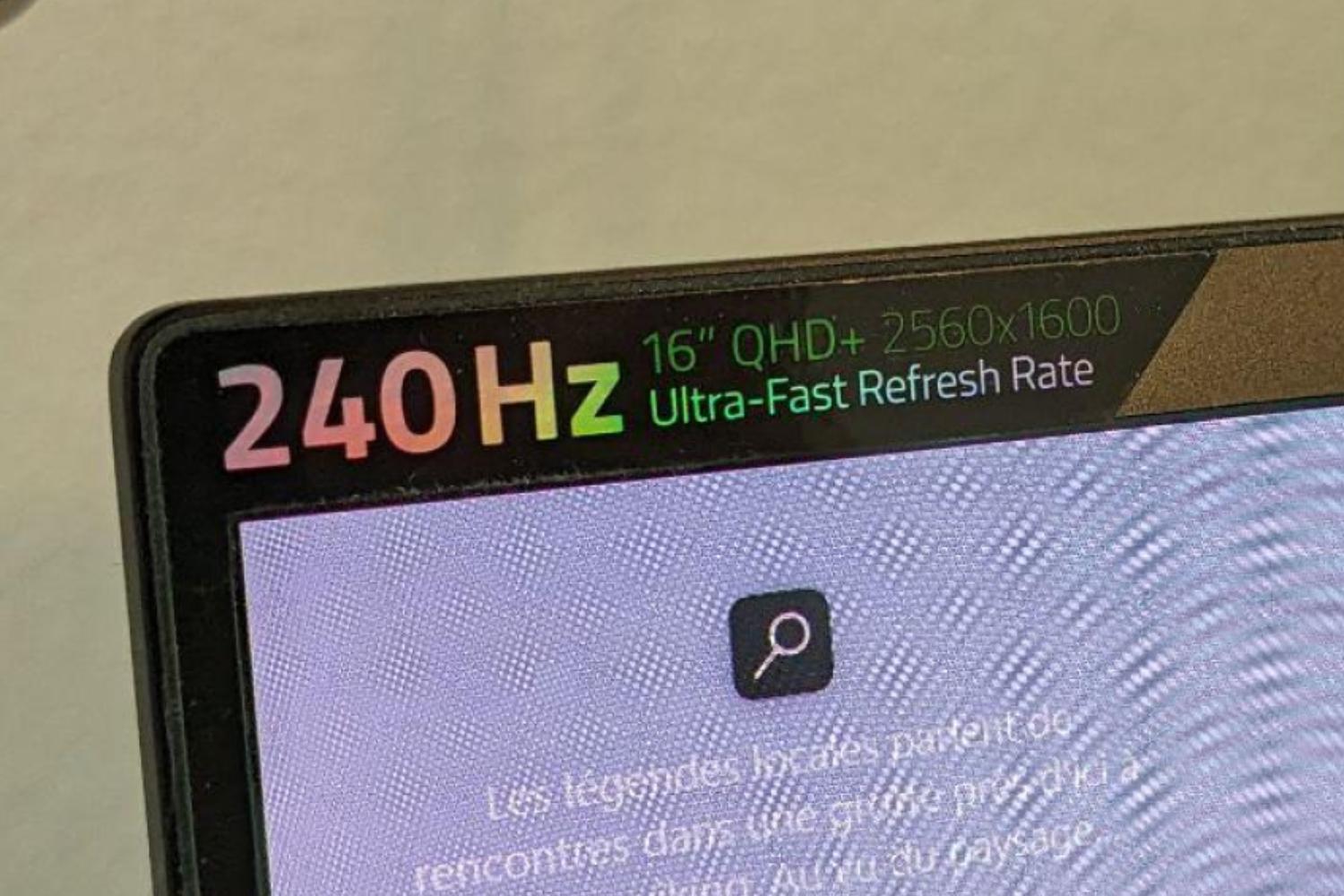
It is also worth mentioning the rather effective anti-reflective coating, which, even if it cannot compete with a real matte panel, does not allow the screen to turn into a mirror as soon as the angle of illumination is not ideal, unlike some of the direct his competitors.
The only criticism that can be leveled at it is the maximum brightness, which is limited to a modest 400 nits. But in general, this screen is a real miracle, and it undoubtedly is machine argument number 1. Whatever game you choose, this Blade 16 is sure to impress, literally and figuratively.
Keyboard
A floor down we find a keyboard that’s still convincing, if a little confusing at first glance – the fault of Razer’s rather specific layout and the slight indentation that can cause some loss of bearings. On the other hand, tactile feedback is always well defined. We found it comfortable during long gaming and typing sessions, although mechanical keyboard fans may be a little disappointed by the extremely short stroke of the layers.
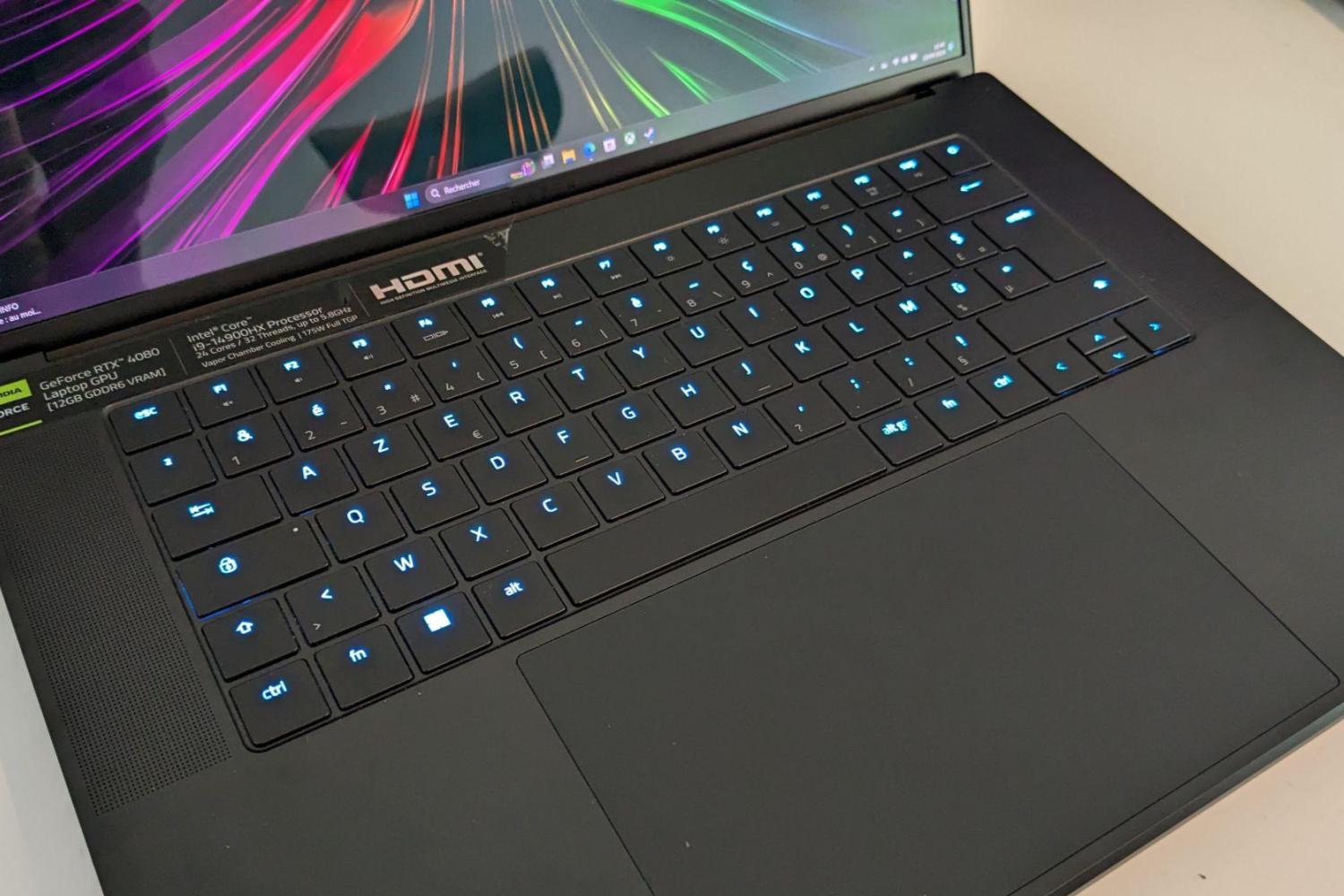
The trackpad, on the other hand, is absolutely huge — a real advantage on paper, but not always in practice, knowing that the finger has to move far to the side to be able to left-click using the mechanical switch. At the very least, it’s flawless in terms of responsiveness and precision.
Hardware and performances
So let’s get to the heart of the matter with the hardware. Unsurprisingly, this premium model is damn well equipped with Intel Core i9 14900HX with 24 cores (8 P-cores at 5.8 GHz turbo, 16 E-cores) for 32 threads, a RTX 4080 Portableand others 32 GB DDR5 with a clock frequency of 5600 MHz.
Reading these specs, there’s reason to be a little worried because usually the type of suit that reeks of thermal throttling… but we were pleasantly surprised.
Unsurprisingly, this Blade 16 is a thick brute in terms of raw performance. It comfortably crosses the 18,000-point mark on the 3DMark TimeSpy benchmark, and the processor also responds with more than convincing results in Cinebench R23, both in single-core and multi-core mode. Of course, the processor is slightly limited (it is impossible to exceed 5.6 GHz during our benchmarks), but we still have impressive numbers. The Blade 16 is certainly behind the leaders in this category like the MSI Titan, but it remains more than powerful enough to handle almost anything, especially in the context of video games, where the processor very rarely needs to be pushed to its limits.
It also proves to be quite stable during extended gaming sessions. For example, we were able to run titles like Cyberpunk 2077 in 2560 x 1600 resolution, Ultra quality with ray tracing for a good hour without the slightest drop below 50 fps (with DLSS enabled) – a sign that temperature management is satisfactory. Let’s take this opportunity to mention that the fans seemed significantly more discreet than those on the Blade 15 2023, although they obviously remain quite audible – especially the CPU one, which has the annoying habit of making a high-pitched screech when put under pressure.
But overall we were satisfied with this test session. The Blade 16 handles this notoriously difficult-to-cool CPU/GPU combination relatively well, with a good balance between raw performance and cooling. Increasing the weight of the chassis, which leaves more room for the steam chamber, seems to have paid off.
Connections
In terms of connectivity, there are two USB Type-A ports, a USB Type-C port and an audio jack on the left, then a USB Type-A port, a Thunderbolt compatible USB Type-C port, a full-size HDMI socket and an SD card reader on the right.
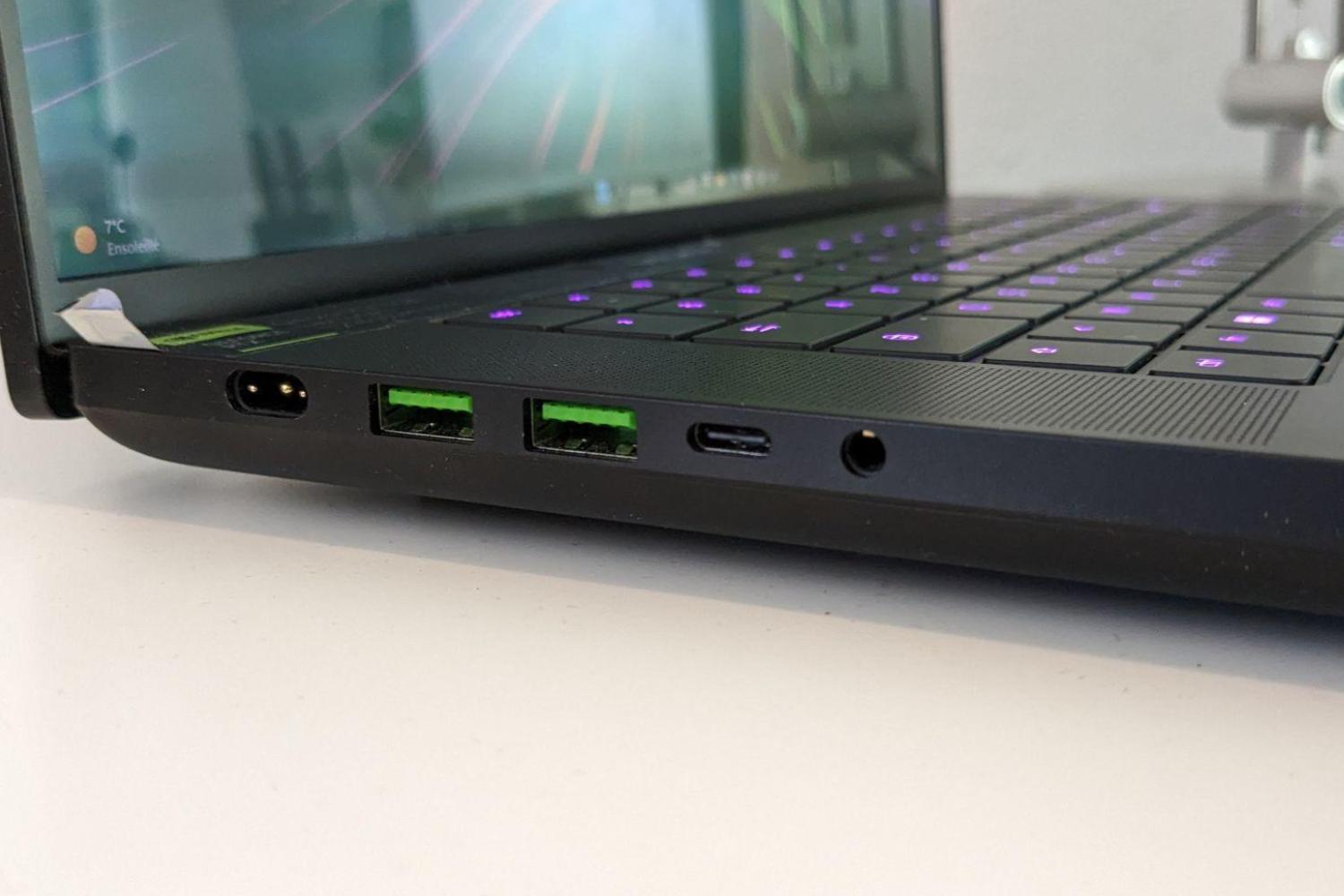
Sufficient in most cases… but not perfect. Sorry for the lack of support for Thunderbolt 5, the native charger port. And most notably the lack of an RJ45 Ethernet socket – always disappointing on a gaming laptop. Nothing overwhelming, but still disappointing, knowing we’re talking about an ultra-premium machine.
Price and availability
This brings us directly to the vexing question, namely that of price. We can say it right now, your accountant might be looking grim because Blade 16 starts at… 3499.99 € with RTX 4070. Our model with RTX 4080, on the other hand, is available at 4199.99 €. And forget about version 4090 entirely; we’re left with the belief that this card simply has no place in a laptop, especially when it adds another €1,000 to the bill.
Definitely a tough price to swallow. Of course, all gaming laptops tend to be overpriced, but even with that in mind, the Blade 16 remains extremely expensive. For reference, we find the Legion 7i 16 with comparable specs (RTX 4080, i9 14900HX, 32 GB DDR5) at €2,699 on Lenovo’s website… Of course, the latter is only entitled to an IPS panel, which is light years away from that great OLED screen. But does that justify such a gap? Probably not for most users…

